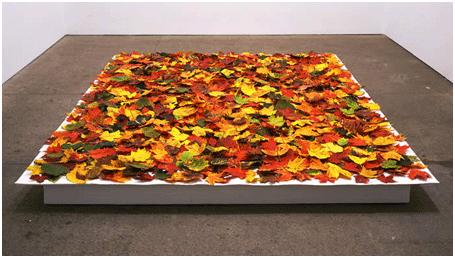
"Fallen"
2005
Dimensions variable
I have a bias against political "protest art." Excepting Pablo Picasso's "Guernica," I am hard pressed to think of moving, successful artworks in this all-too-noisy stall of the political art stable. I don't mean to suggest that artists shouldn't bang a drum on behalf of causes near and dear to them, but doing so without looking like an ass is no mean task.
Thankfully, there are a number of artists who produce work that addresses contemporary political concerns without throwing a tantrum; I didn't realize that Jane Hammond was one of them. I like Hammond's collages - and some of her paintings - a great deal, so I was thrilled to read about her installation/sculpture, "Fallen," exhibited last year at Galerie Lelong. Unfortunately, I missed the show. I include below critic Eleanor Heartney's description of the work, printed in the September 2005 issue of Art in America.
"In the show's largest work...a pile of large, brilliantly colored autumn leaves spread[s] over a low platform in the center of a separate room. Actually, these remarkably real-looking leaves are artful reproductions of ones gathered by the artist and her friends...Hammond inscribed each of the roughly 1,500 leaves with the name of an American soldier killed in Iraq. (As the war goes on, she will continue to add leaves as more soldiers die.) Thus, what first appears to be a celebration of nature's beauty becomes a reminder of the mounting toll of war."At the time of the exhibition, "Fallen" was comprised of more than 1,500 leaves. Presumably, Hammond has dutifully continued fashioning her paper leaves, which should now number just over 2,200. The process of shaping, inscribing and adding these leaves must be a very difficult one, but I am thankful for the project and ever more impressed with Hammond as an artist.
Read the 2010 follow-up to this post here.
Photo credit: image ripped from .nsimplexity

5 comments:
A year before “Guernica,” and in the same country, Dali painted “Soft Construction With Boiled Beans,” which I'd consider another success. I agree that political art is a tightrope act that usually fails, and that failure is usually embarrassing. Using art as a soapbox invariably fails. The secret is to compartmentalize your political self and rely on artistic principles rather than ideological ones as you do the work, without forgetting how you were moved by the original political thought. From the sounds of it, Hammond succeeded nicely in doing that. Thanks to you both!
cpbvk:
I agree. I also feel artists - nay, the populace at large - must remain eternally vigilant...and it ain't always easy!
cpbvk:
Great work, by the way. I'll make a point of checking in from time to time.
Zara:
As Wallace Stegner writes in his novel, "All The Little Live Things," "It's only the literary, hot for novelty, who fear cliche, and I am no longer of that tribe."
There was a time, certainly, when I would have rejected the concept of "Fallen" as cringe-worthy, and there will always be works I reject as trite, but there is an important distinction between "trite" and "cliche." The former is shallow and best avoided. The latter, not so much...if handled well.
Furthermore, the fact that "Fallen" might have been conceived by a six year-old adds to it's simple poetry. Simple gestures are commonly profound, even if rarely avant-garde or "high."
If Hammond's work were seen by a more broad public, it would provoke a great many viewers. That's more than can be said for just about any other work today. If you want to take to a leaf-blower to that fact, be my guest, but I'd wager that your tantrum will pass, and that one day you'll reconsider your angry dismissal of "Fallen."
Post a Comment